Philippine–American War
| Philippine–American War | |||||||||
|---|---|---|---|---|---|---|---|---|---|
    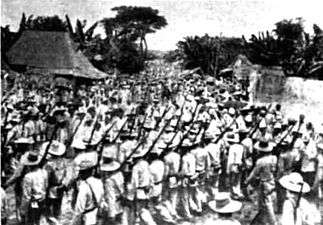 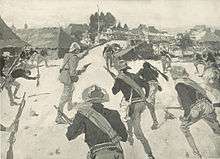 Clockwise from top left: U.S. troops in Manila, Gregorio del Pilar and his troops around 1898, Americans guarding Pasig River bridge in 1898, Battle of Santa Cruz, Philippine Soldiers at Malolos, Battle of Quingua. | |||||||||
The Philippine–American War (Spanish: Guerra Filipino-Estadounidense, Filipino: Digmaang Pilipino-Amerikano) (1899–1902)[14] was an armed conflict between the First Philippine Republic (Spanish: República Filipina) and the United States. The conflict arose when the First Philippine Republic objected to the terms of the Treaty of Paris under which the United States took possession of the Philippines from Spain, ending the Spanish–American War.[15][16] The war was a continuation of the Philippine struggle for independence that began in 1896 with the Philippine Revolution. Fighting erupted between United States and the Philippine Republic forces on February 4, 1899 and quickly escalated into the 1899 Second Battle of Manila. On June 2, 1899, the First Philippine Republic officially declared war against the United States.[17] The war officially ended on July 2, 1902[18] with a victory for the United States. However, some Philippine groups led by veterans of the Katipunan continued to battle the American forces. Among those leaders was General Macario Sacay, a veteran Katipunan member who assumed the presidency of the proclaimed "Tagalog Republic", formed in 1902 after the capture of President Emilio Aguinaldo. Other groups continued hostilities in remote areas and islands, including the Moro people and Pulahanes people, until their final defeat a decade later at the Battle of Bud Bagsak on June 15, 1913.[1][2] The war and occupation by the U.S. changed the cultural landscape of the islands, as people dealt with an estimated 34,000 to 220,000 Philippine casualties (with more civilians dying from disease and hunger brought about by war), disestablishment of the Roman Catholic Church in the Philippines (as a "state Church" as previously in Spain), and the introduction of the English language in the islands as the primary language of government, education, business, industry, and among families and educated individuals increasingly in future decades. Filipinos were initially given very limited self-government under the 1902 "Philippine Organic Act" passed by the United States Congress, including the right to vote for some elected officials such as an elected Philippine Assembly. The U.S. officially promised independence 14 years later, along with more Philippine control over the Philippines in the meantime, with the 1916 Philippine Autonomy Act (or "Jones Act") passed by the United States Congress during the administration of Democratic 28th President Woodrow Wilson. The 1934 Philippine Independence Act created the Commonwealth of the Philippines the following year, a limited form of independence, and established a process ending in Philippine independence (originally scheduled for 1944, but interrupted and delayed by World War II). The United States granted independence in 1946, following World War II and the Japanese Occupation of the Philippines, through the Treaty of Manila concluded between the two governments and nations. NomenclatureThe war is historically known as Guerra Filipino-Estadounidense in Spanish, the language used by a majority of the Philippine revolutionaries.[19] In Tagalog it is known as Digmaang Pilipino-Amerikano. In the United States, it has been known by a variety of names, including the Philippine Insurrection, the Philippine-American War, the Filipino-American War, the Philippine War, the Tagalog Insurgency,[20] and the Philippine Revolution.[21] In 1999 the U.S. Library of Congress reclassified its references to use the term Philippine-American War.[22] Military engagements involving American forces in Mindanao in the early 20th century are sometimes referred to separately and collectively as The Moro War or The Moro-American War. The "Katipunan" spread throughout the provinces, and the "Philippine Revolution" of 1896 was led by its members, called "Katipuneros".[23][24][25] BackgroundPhilippine RevolutionMain article: Philippine Revolution
Andrés Bonifacio was a warehouseman and clerk from Manila. He established "Katipunan" on July 7, 1892, a revolutionary organization which aimed to gain independence from Spanish colonial rule by armed revolt. Fighters in Cavite province won early victories. One of the most influential and popular Cavite leaders was Emilio Aguinaldo, mayor of Cavite El Viejo (modern-day Kawit), who gained control of much of the eastern Cavite province. Eventually, Aguinaldo and his faction gained control of the leadership of the movement. In 1897, Aguinaldo was elected president of an insurgent government of the First Philippine Republic while the “outmaneuvered”[1] Bonifacio was executed for treason.[1][26] Aguinaldo is officially considered the first president of the Philippines. Aguinaldo's exile and return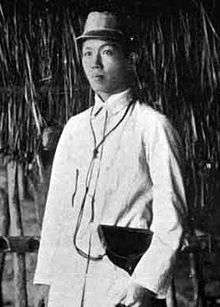 Emilio Aguinaldo in the field  Personifying the United States, "Uncle Sam" chases a bee representing Emilio Aguinaldo, the President of the Philippine Republic on the Islands from March 22, 1897 to April 1, 1901. In 1901, two years after this cartoon's publication in America, at the end of the "Philippine Insurrection" / Philippine–American War, Aguinaldo would surrender control of the Philippines to the United States. By December 1897, the fight had come to a stalemate. In August 1897, "armistice" negotiations were opened between President Aguinaldo and the Spanish governor-general, Fernando Primo de Rivera. By mid-December an agreement was reached in which the Governor would pay Aguinaldo a sum described in the Agreement as "$800,000 (Mexican pesos)" in three installments if Aguinaldo would go into exile.[27][28] Aguinaldo then established himself in Hong Kong.[27][29] Before leaving, Aguinaldo denounced the Revolution, exhorted Filipino rebel combatants to disarm and declared those who continued hostilities and waging war to be bandits.[1] However, some Philippine revolutionaries did continue armed struggle against the Spanish colonial government.[1][30][31][32][33][34] Aguinaldo wrote retrospectively in 1899 that he had met with U.S. Consuls E. Spencer Pratt and Rounceville Wildman in Singapore in 1898 between April 22 and 25 and that they persuaded him to again take up the mantle of leadership in the revolution, with Pratt communicating with Admiral George Dewey (the U.S. Navy's Asiatic Squadron commander) by telegram, passing assurances from Dewey to Aguinaldo that the United States would at least recognize the independence of the Philippines under the protection of the United States Navy, and adding that there was no necessity for entering into a formal written agreement because the word of the Admiral and of the United States Consul were in fact equivalent to the most solemn pledge that their verbal promises and assurance would be fulfilled to the letter and were not to be classed with Spanish promises or Spanish ideas of a man’s word of honor.[35] Aguinaldo reports agreeing to return to the Philippines, traveling from Singapore to Hong Kong aboard the steamship Malacca, onwards from Hong Kong on American dispatch-boat McCulloch, and arriving in Cavite on May 19.[35] The New York Times wrote on August 6, 1899 that Pratt had obtained a court order enjoining the publication of certain statements "... which might be regarded as showing a positive connection" between himself and Aguinaldo.[36] The Times reports the court ruling to uphold Mr. Pratt's position that he had "no dealings of a political character" with Aguinaldo and the book publisher withdrew from publication statements to the contrary.[36] In Camiguin, Aguinaldo reports meeting with Admiral Dewey, and recalls: "I asked whether it was true that he had sent all the telegrams to the Consul at Singapore, Mr. Pratt, which that gentleman had told me he received in regard to myself. The Admiral replied in the affirmative, adding that the United States had come to the Philippines to protect the natives and free them from the yoke of Spain. He said, moreover, that America is exceedingly well off as regards territory, revenue, and resources and therefore needs no colonies, assuring me finally that there was no occasion for me to entertain any doubts whatever about the recognition of the Independence of the Philippines by the United States."[35] By late May, Dewey had been ordered by the U.S. Department of the Navy to distance himself from Aguinaldo lest he make untoward commitments to the Philippine forces.[37]  A late 19th century photograph of Filipino Katipuneros. In a matter of months after Aguinaldo's return, Philippine revolutionary forces conquered nearly all of Spanish-held ground within the Philippines. With the exception of Manila, which was surrounded by revolutionary forces some 12,000 strong, the Filipinos now controlled the Philippines. Aguinaldo also turned over 15,000 Spanish prisoners to the Americans, offering them valuable intelligence. On June 12 Aguinaldo declared independence at his house in Cavite El Viejo. Spanish Governor-General Fermín Jáudenes had made a secret agreement with Dewey and General Wesley Merritt. Jaudenes specifically requested to surrender only to the Americans, not to the Filipino revolutionaries. To save face, he proposed a mock battle with the Americans preceding the Spanish surrender; the Filipinos would not be allowed to enter the city. Dewey and Merritt agreed to this, and no one else in either camp knew about the agreement. On the eve of the mock battle, General Thomas M. Anderson telegraphed Aguinaldo, "Do not let your troops enter Manila without the permission of the American commander. On this side of the Pasig River you will be under fire".[38] On August 13, with American commanders unaware that a peace protocol had been signed between Spain and the United States on the previous day, American forces captured the city of Manila from the Spanish.[39] 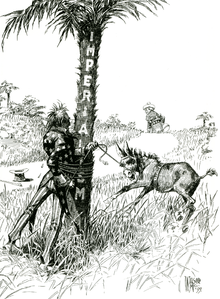 1899 political cartoon by Winsor McCay Before the attack on Manila, American and Filipino forces had been allies against Spain in all but name. After the capture of Manila, Spanish and Americans were in a partnership that excluded the Filipino insurgents. Fighting between American and Filipino troops had almost broken out as the former moved in to dislodge the latter from strategic positions around Manila on the eve of the attack. Aguinaldo had been told bluntly by the Americans that his army could not participate and would be fired upon if it crossed into the city. The insurgents were infuriated at being denied triumphant entry into their own capital, but Aguinaldo bided his time. Relations continued to deteriorate, however, as it became clear to Filipinos that the Americans were in the islands to stay.[37] The June 12 declaration of Philippine independence had not been recognized by either the United States or Spain, and the Spanish government ceded the Philippines to the United States in the 1898 Treaty of Paris, which was signed on December 10, 1898, in consideration for an indemnity for Spanish expenses and assets lost. On January 1, 1899, Aguinaldo was declared President of the Philippines—the only president of what would be later called the First Philippine Republic.[40] He later organized a Congress at Malolos, Bulacan to draft a constitution.[41] Admiral Dewey later argued that he had promised nothing regarding the future: "From my observation of Aguinaldo and his advisers I decided that it would be unwise to co-operate with him or his adherents in an official manner. ... In short, my policy was to avoid any entangling alliance with the insurgents, while I appreciated that, pending the arrival of our troops, they might be of service."[33] Sideco house (seat of Emilio Aguinaldo's First Philippine Republic)The Crispulo Sideco (also known as "Kapitang Pulong") house [42] San Isidro, Nueva Ecija, was built in the 19th century (Floral period in the Philippine colonial architecture; ogee arches, filigreed wooden panels, grilles wrought in curlicues and floral and foliate designs abound in the house as basic structural elements or as ornaments). The house had been the "seat" of General Emilio Aguinaldo's First Philippine Republic when he established it as his headquarters in San Isidro during the last part of his odyssey from the American forces. Sideco house served originally as Col. Frederick Funston's (U.S. Army) headquarters, and then later as Emilio Aguinaldo's "seat" or "capitol" from the fall of Malolos on March 31, 1899 until May 17, 1899, when San Isidro was taken by the Americans. On the 29th of March 1899, President/General Emilio Aguinaldo arrived in San Isidro, Nueva Ecija and proclaimed the town capital of the First Philippine Republic. He stayed in this house which served as the "de facto" temporary Philippine capitol. When the Americans occupied San Isidro, the Sideco house served as the headquarters of Col. Frederick Funston, who would later capture President/General Aguinaldo in Palanan, Isabela. Aguinaldo's future capture is said to have been planned in this house.[43][44] As of 2006 it was reported to be occupied by a Christian religious organization.[43] War against the United StatesConflict origins American soldiers guard a bridge over the Pasig River after the Battle of Manila, August 13, 1898 Filipino historian Teodoro Agoncillo writes of "American Apostasy", saying that it was the Americans who first approached Aguinaldo in Hong Kong and Singapore to persuade him to cooperate with Dewey in wresting power from the Spanish. Conceding that Dewey may not have promised Aguinaldo American recognition and Philippine independence (Dewey had no authority to make such promises), he writes that Dewey and Aguinaldo had an informal alliance to fight a common enemy, that Dewey breached that alliance by making secret arrangements for a Spanish surrender to American forces, and that he treated Aguinaldo badly after the surrender was secured. Agoncillo concludes that the American attitude towards Aguinaldo "... showed that they came to the Philippines not as a friend, but as an enemy masking as a friend."[45] 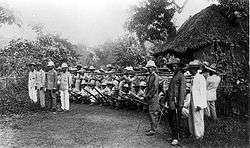 Filipino soldiers outside Manila in 1899 On December 21, 1898, President McKinley issued a Proclamation of Benevolent assimilation. General Otis delayed its publication until January 4, 1899, then publishing an amended version edited so as not to convey the meanings of the terms "sovereignty", "protection", and "right of cessation" which were present in the unabridged version.[46] However, General Marcus Miller, then in Iloilo and unaware that an altered version had been published by Otis, passed a copy of the unabridged proclamation to a Filipino official there. The unaltered version then found its way to Aguinaldo who, on January 5, issued a counter-proclamation:[47] "My government cannot remain indifferent in view of such a violent and aggressive seizure of a portion of its territory by a nation which arrogated to itself the title of champion of oppressed nations. Thus it is that my government is disposed to open hostilities if the American troops attempt to take forcible possession of the Visayan islands. I denounce these acts before the world, in order that the conscience of mankind may pronounce its infallible verdict as to who are true oppressors of nations and the tormentors of mankind.[48] In a revised proclamation issued the same day, Aguinaldo protested "most solemnly against this intrusion of the United States Government on the sovereignty of these islands".[49] Otis regarded these two proclamations as tantamount to war, alerting his troops and strengthening observation posts. On the other hand, Aguinaldo's proclamations energized the masses with a vigorous determination to fight what was perceived as an ally turned enemy.[49] On the evening of February 4, two American sentries, one of which was Pvt. Robert William Greyson, fired the first shots at Filipino troops at the corner of Sociego and Silencio Streets[50][51] in Santa Mesa, Manila which triggered the 1899 Battle of Manila. The following day, General Arthur MacArthur, without investigating the cause of the firing, ordered his troops to advance against Filipino troops, beginning a full-scale armed clash.[52] The name of the first Filipino fatality of the war was Corporal Anastacio Felix of the 4th Company, Morong Battalion under Captain Serapio Narvaez. The battalion commander was Col. Luciano San Miguel. First Philippine CommissionMain article: Schurman Commission
 Wounded American soldiers at Santa Mesa, Manila in 1899. On January 20, 1899, President McKinley had appointed Dr. Jacob Gould Schurman to chair a commission, with Dean C. Worcester, Charles H. Denby, Admiral Dewey, and General Otis as members, to investigate conditions in the islands and make recommendations. Fighting subsequently erupted between U.S. and Filipino forces in February, and when the non-military commission members arrived in the Philippines in March, they found General Otis looking upon the commission as an infringement upon his authority.[53][54][55][18] Meetings in April with Aguinaldo's representative, Colonel Manuel Arguelles, convinced the commission that Filipinos wanted concrete information on the governmental role they would be allowed to play, and the commission requested authorization from McKinley to offer a specific plan. McKinley authorized an offer of a government consisting of "a Governor-General appointed by the President; cabinet appointed by the Governor-General; [and] a general advisory council elected by the people." McKinley also promised Filipinos "the largest measure of local self-government consistent with peace and good order.", with the caveat that U.S. constitutional considerations required that Congress would need to make specific rules and regulations.[56] A session of the Revolutionary Congress convened by Aguinaldo voted unanimously to cease fighting and accept peace on the basis of McKinley's proposal. The revolutionary cabinet headed by Apolinario Mabini was replaced on May 8 by a new "peace" cabinet headed by Pedro Paterno. and Felipe Buencamino. After a meeting of the Revolutionary Congress and military commanders, Aguinaldo advised the commission that he was being advised by a new cabinet "which is more moderate and concilatory", and appointed a delegation to meet with the commission. At this point, General Antonio Luna, field commander of the revolutionary army, arrested Paterno and most of his cabinet. Confronted with this development, Aguinaldo withdrew his support from the "peace" cabinet, and Mabini and his cabinet returned to power. Schurman, after proposing unsuccessfully to the commission that they urge McKinley to revise his plan to enlarge Filipino participation, cabled the suggestion to the President as his own. McKinley instructed Secretary of State John Hay to cable Schurman that he wanted peace "preferably by kindness and conciliation," but the preference was contradicted by a threat to "send all the force necessary to suppress the insurrection if Filipino resistance continued." McKinley also polled the other commission members, receiving a response that "indecision now would be fatal" and urging "prosecution of the war until the insurgents submit."[57] 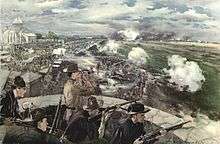 The battle before Caloocan, Maj. Gen. Arthur MacArthur on inner wall, February 1899 In the report that they issued to the president the following year, the commissioners acknowledged Filipino aspirations for independence; they declared, however, that the Philippines was not ready for it. Specific recommendations included the establishment of civilian control over Manila (Otis would have veto power over the city's government), creation of civilian government as rapidly as possible, especially in areas already declared "pacified" (the American chief executive in the islands at that time was the military governor), including the establishment of a bicameral legislature, autonomous governments on the provincial and municipal levels, and a system of free public elementary schools.[54] On November 2, 1900 Dr. Schurman signed the following statement: "Should our power by any fatality be withdrawn, the commission believe that the government of the Philippines would speedily lapse into anarchy, which would excuse, if it did not necessitate, the intervention of other powers and the eventual division of the islands among them. Only through American occupation, therefore, is the idea of a free, self-governing, and united Philippine commonwealth at all conceivable. And the indispensable need from the Filipino point of view of maintaining American sovereignty over the archipelago is recognized by all intelligent Filipinos and even by those insurgents who desire an American protectorate. The latter, it is true, would take the revenues and leave us the responsibilities. Nevertheless, they recognize the indubitable fact that the Filipinos cannot stand alone. Thus the welfare of the Filipinos coincides with the dictates of national honour in forbidding our abandonment of the archipelago. We cannot from any point of view escape the responsibilities of government which our sovereignty entails; and the commission is strongly persuaded that the performance of our national duty will prove the greatest blessing to the peoples of the Philippine Islands. [...]"[58] Second Philippine CommissionThe Second Philippine Commission (the Taft Commission), appointed by McKinley on March 16, 1900, and headed by future president William Howard Taft, was granted legislative as well as limited executive powers. Between September 1900 and August 1902 it issued 499 laws. A judicial system was established, including a Supreme Court, and a legal code was drawn up to replace antiquated Spanish ordinances. A civil service was organized. The 1901 municipal code provided for popularly elected presidents, vice presidents, and councilors to serve on municipal boards. The municipal board members were responsible for collecting taxes, maintaining municipal properties, and undertaking necessary construction projects; they also elected provincial governors.[55][59] American war strategyAmerican tactics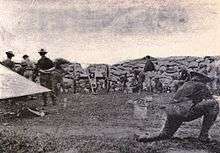 Utah Light Artillery in action in the Philippines, 1899 The initial American military strategy was to secure Manila from the Filipino soldier. Once this was accomplished, American forces moved northwards, engaging in combat at the brigade and battalion level in pursuit of the fleeing insurgent commanders.[60] After the rebels shifted to guerilla warfare tactics in November 1899, American military strategy shifted from a conventional footing to a suppression footing. Tactics were changed toward control of key areas with internment and segregation of the civilian population in "zones of protection" from the guerrilla population. Due to unsanitary conditions, many of the interned died from dysentery.[61] Support for American imperial actions in the Philippines was justified by those in the U.S. government and media who supported the conflict through the use of moralistic oration. Stuart Creighton Miller writes "Americans altruistically went to war with Spain to liberate the Cubans, Puerto Ricans, and Filipinos from their tyrannical yoke. If they lingered on too long in the Philippines, it was to protect the Filipinos from European predators waiting in the wings for an American withdrawal and to tutor them in American-style democracy."[62] General Otis's actionsGeneral Otis gained a significant amount of notoriety for his actions in the Philippines. Although multiple orders were given to Otis from Washington to avoid military conflict, he did very little to circumvent the breakout of war. Notably, shortly after fighting began he turned down a proposal from Emilio Aguinaldo to end the fighting, stating "fighting, having begun, must go on to the grim end." Otis refused to accept anything but unconditional surrender from the Philippine Army. He often made major military decisions on his own, without first consulting leadership in Washington at all. He acted aggressively in dealing with the Filipinos under the impression that their resistance would collapse quickly; even after this proved false, he continued to insist that the insurgency had been defeated, and that the remaining casualties were caused by "isolated bands of outlaws".[63]  Kansas Volunteers marching through Caloocan at night, 1899 Otis also played a large role in suppressing information about American military tactics from the media. When letters describing American atrocities reached the American media, the War Department became involved and demanded that General Otis investigate their authenticity. Each press clipping was forwarded to the original writer's commanding officer, who would then convince or force the soldier to write a retraction of the original statements.[64] Meanwhile, Otis claimed that Filipino insurgents tortured American prisoners in "fiendish fashion".[65] During the closing months of 1899 Emilio Aguinaldo attempted to counter General Otis's account by suggesting that neutral parties—foreign journalists or representatives of the International Red Cross—inspect his military operations. Otis refused, but Emilio Aguinaldo managed to smuggle four reporters—two English, one Canadian, and one Japanese—into the Philippines. The correspondents returned to Manila to report that American captives were "treated more like guests than prisoners," were "fed the best that the country affords, and everything is done to gain their favor." The story went on to say that American prisoners were offered commissions in the Filipino army and that three had accepted. The four reporters were expelled from the Philippines as soon as their stories were printed.[66][67][68] Naval Lieutenant J.C. Gilmore, whose release was forced by American cavalry pursuing Aguinaldo into the mountains, insisted that he had received "considerable treatment" and that he was no more starved than were his captors. Otis responded to publication of two articles concerning this by ordering the "capture" of the two authors, and that they be "investigated", therefore questioning their loyalty.[66][69] 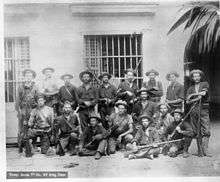 Picture of Young's Scouts in Philippines, including Marcus W. Robertson When F.A. Blake of the International Red Cross arrived at Emilio Aguinaldo's request, Otis kept him confined to Manila, where Otis's staff explained all of the Filipinos' violations of civilized warfare. Blake managed to slip away from an escort and venture into the field. Blake never made it past American lines, but even within American lines he saw burned out villages and "horribly mutilated bodies, with stomachs slit open and occasionally decapitated." Blake waited to return to San Francisco, where he told one reporter that "American soldiers are determined to kill every Filipino in sight."[70][71][72][73] Signal Corps' Role in the PhilippinesPurpose of the Signal CorpsThe Signal Corps is a division of the United States Army, often referred to as the Signal Corps (United States Army) (USASC). In general, the Signal Corps is used to provide communication and information systems for the efforts of combined armed forces. The USASC, before the Philippine–American War, was a small division of the Army and had virtually no significance. However, during the Philippine–American War this changed. The need for telephone wires and visual signaling increased, and demand for more Signal Corps officers increased. On May 18, 1898 an Act of Congress was approved which allowed for the creation of a Volunteer Signal Corps to serve during the war. For years the Army Regulations had a stipulation that a certain percentage of soldiers be proficient in signalling, but with the creation of the Volunteer Signal Corps, the number of experts greatly decreased. Despite this, the Signal Corps proved highly efficient. This could be attributed to the number of ranking officers in each division of the USASC.[74] In each organized division of the Volunteer Signal Corps there had to be at least one colonel, one lieutenant colonel, one major, two captains, two first lieutenants, two second lieutenants, five first-class sergeants, ten sergeants, ten corporals, and thirty privates. Of these officers and enlisted men, two-thirds had to be skilled electricians or telegraph operators. This ensured that most members of the Signal Corps understood and were competent with the tools needed to successfully implement signaling advantages in the Philippines.[74] Contribution of the Signal CorpsAfter Spain left the Philippines, American troops were still involved in a guerilla war-torn Philippines. The USASC remained present, and it was important to continue the advances the USASC had already made. During the Philippine insurrection, the USASC aimed to construct, maintain, and operate an effective communication system between all the major islands of the Philippines. By the end of 1899, the Signal Corps had already connected Leyte, Cebu, and Samar.[75] In addition to connecting these islands, the Corps aided by providing visual signaling, in the form of heliograph, supplying telephone and telegraph wire lines. This was the first time that telephones had been used in combat and that combat photography had been used. A heliograph is a wireless solar telegraph that signals by flashes of sunlight (generally using Morse code) reflected by a mirror.[75] The most common form of telegraph wire was known as the "flying lines"[74] which got its name from the ability to construct these lines. These lines were developed one of two ways: either by laying insulated wire on the ground or by throwing it upon bushes and trees. To demonstrate the speed with which these lines can be created, the example of American troops creating a line at Manila is often used. A telegraph station was established inside Spanish entrenchments just a mere fifteen minutes after American troops had captured the Spanish camps.[74] The Philippine–American War was a stepping-stone for the Signal Corps' new endeavors. The use of telephones in battle, heliographs, and combat photography in this war was only the beginning of the participation of the USASC in active wars. Shortly following this war, the Signal Corps constructed the Washington-Alaska Military Cable and Telegraph System, thereby introducing the first wireless telegraph in the Western Hemisphere.[76] Anthony Morris LeafdaleAnthony Morris Leafdale, a member of USASC, traveled to the Philippines from Fort Walla Walla, Washington. During this time Leafdale kept a diary in which he logged his everyday assignments for signaling and his interactions with Filipinos. Immediately upon getting into Manila Bay, Leafdale remarks on the civility displayed by the natives. He describes his initial thoughts as the Filipinos looking "as savage and wild as [he] had imagined them to be".[77] This contrasts the propaganda campaigns which had been occurring in the United States that claimed the natives were "unfit for self-government".[78] This is important to mention because it shows the contrast between propaganda campaigns and what soldiers were experiencing in the Philippines. Leafdale uses his diary to describe and keep a record of his duties while in the Philippines. On 1/12/1900, Leafdale writes of how he and some of his colleagues were on a "train to Dagupan to receive instructions […] to build lines, or rather repair Spanish lines between there and Subig". The lines he is referring to are the telephone lines that the Signal Corps was working on laying down. These were a much more effective form of communication than telegrams or hand-written letters.[77] Filipino war strategy Manila—Filipino attack on the barracks of Co. C, 13th Minnesota Volunteers, during the Tondo Fire. Estimates of the Filipino forces vary between 80,000 and 100,000, with tens of thousands of auxiliaries.[6] Lack of weapons and ammunition was a significant impediment to the Filipinos, so most of the forces were only armed with bolo knives, bows and arrows, spears and other primitive weapons that, in practice, proved vastly inferior to U.S. firepower. 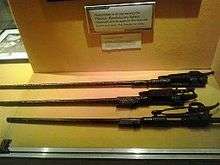 Remnants of rifles used by Filipino soldiers during the War on display at Clark Museum. The Philippine Army suffered a shortage of firearms and was forced to arm its soldiers with primitive weapons. The goal, or end-state, sought by the First Philippine Republic was a sovereign, independent, socially stable Philippines led by the ilustrado (intellectual) oligarchy.[79] Local chieftains, landowners, and businessmen were the principales who controlled local politics. The war was strongest when illustrados, principales, and peasants were unified in opposition to annexation.[79] The peasants, who provided the bulk of guerrilla manpower, had interests different from their illustrado leaders and the principales of their villages.[79] Coupled with the ethnic and geographic fragmentation, unity was a daunting task. The challenge for Aguinaldo and his generals was to sustain unified Filipino public opposition; this was the revolutionaries' strategic center of gravity.[79] The Filipino operational center of gravity was the ability to sustain its force of 100,000 irregulars in the field.[80] The Filipino general Francisco Macabulos described the Filipinos' war aim as, "not to vanquish the U.S. Army but to inflict on them constant losses." They initially sought to use conventional tactics and an increasing toll of U.S. casualties to contribute to McKinley's defeat in the 1900 presidential election.[80] Their hope was that as President the avowedly anti-imperialist future Secretary of state William Jennings Bryan would withdraw from the Philippines.[80] They pursued this short-term goal with guerrilla tactics better suited to a protracted struggle.[80] While targeting McKinley motivated the revolutionaries in the short term, his victory demoralized them and convinced many undecided Filipinos that the United States would not depart precipitously.[80] Guerrilla war phaseFor most of 1899, the revolutionary leadership had viewed guerrilla warfare strategically only as a tactical option of final recourse, not as a means of operation which better suited their disadvantaged situation. On November 13, 1899, Emilio Aguinaldo decreed that guerrilla war would henceforth be the strategy.[81] This made American occupation of the Philippine archipelago all the more difficult over the next few years. In fact, during just the first four months of the guerrilla war, the Americans had nearly 500 casualties.[82] The Philippine Army began staging bloody ambushes and raids, such as the guerrilla victories at Paye, Catubig, Makahambus, Pulang Lupa, Balangiga and Mabitac. At first, it even seemed as if the Filipinos would fight the Americans to a stalemate and force them to withdraw. This was even considered by President McKinley at the beginning of the phase. The shift to guerrilla warfare drove the US Army to adopt counter-insurgency tactics. Civilians were given identification and forced into concentration camps with a publicly announced deadline after which all persons found outside of camps without identification would be shot on sight. Thousands of civilians died in these camps due to poor conditions.[83] Decline and fall of the First Philippine Republic A group of Filipino combatants are photographed just as they lay down their weapons prior to their surrender. The Philippine Army continued suffering defeats from the better armed United States Army during the conventional warfare phase, forcing Aguinaldo to continually change his base of operations, which he did for nearly the length of the entire war. On March 23, 1901 General Frederick Funston and his troops captured Aguinaldo in Palanan, Isabela, with the help of some Filipinos (called the Macabebe Scouts after their home locale[84][85]) who had joined the Americans' side. The Americans pretended to be captives of the Scouts, who were dressed in Philippine Army uniforms. Once Funston and his "captors" entered Aguinaldo's camp, they immediately fell upon the guards and quickly overwhelmed them and the weary Aguinaldo.[86] On April 1, 1901, at the Malacañan Palace in Manila, Aguinaldo swore an oath accepting the authority of the United States over the Philippines and pledging his allegiance to the American government. On April 19, he issued a Proclamation of Formal Surrender to the United States, telling his followers to lay down their weapons and give up the fight. "Let the stream of blood cease to flow; let there be an end to tears and desolation," Aguinaldo said. "The lesson which the war holds out and the significance of which I realized only recently, leads me to the firm conviction that the complete termination of hostilities and a lasting peace are not only desirable but also absolutely essential for the well-being of the Philippines."[87][88] The capture of Aguinaldo dealt a severe blow to the Filipino cause, but not as much as the Americans had hoped. General Miguel Malvar took over the leadership of the Filipino government, or what remained of it.[89] He originally had taken a defensive stance against the Americans, but now launched all-out offensive against the American-held towns in the Batangas region.[2] General Vicente Lukbán in Samar, and other army officers, continued the war in their respective areas.[2] In response General J. Franklin Bell adopted tactics to counter Malvar's guerrilla strategy. Forcing civilians to live in concentration camps, use of 'water cure' torture interrogation, and his scorched earth campaigns took a heavy toll on the Filipino revolutionaries.[90]  The 24th U.S. Infantry at drill, Camp Walker, Philippine Islands 1902 Bell also relentlessly pursued Malvar and his men, breaking ranks, dropping morale, and forcing the surrender of many of the Filipino soldiers. Finally, Malvar surrendered, along with his sick wife and children and some of his officers, on April 13, 1902. By the end of the month nearly 3,000 of Malvar's men had also surrendered. With the surrender of Malvar, the Filipino war effort began to dwindle even further.[91] Official end to the warThe Philippine Organic Act, approved on July 1, 1902, ratified McKinley's previous executive order which established the Philippine Commission, and stipulated that a legislature would be established composed of a popularly elected lower house, the Philippine Assembly, and an upper house consisting of the Philippine Commission. The act also provided for extending the United States Bill of Rights to Filipinos.[55][59] On July 2. the U.S. Secretary of War telegraphed that since the insurrection against the U.S. had ended and provincial civil governments had been established, the office of military governor was terminated. On July 4, Theodore Roosevelt, who had succeeded to the U.S. Presidency after the assassination of President McKinley on September 5, 1901, proclaimed a full and complete pardon and amnesty to all people in the Philippine archipelago who had participated in the conflict.[18][92] On April 9, 2002, Philippine President Gloria Macapagal Arroyo proclaimed that the Philippine–American War had ended on April 16, 1902 with the surrender of General Miguel Malvar, and declared the centennial anniversary of that date as a national working holiday and as a special non-working holiday in the Province of Batangas and in the Cities of Batangas, Lipa and Tanaun.[93] IrreconcilablesHistorian Renato Constantino has suggested that the war unofficially continued for nearly a decade since remnants of the Katipunan and other resistance groups, collectively known as Irreconcilables, remained active fighting the United States military or Philippine Constabulary.[1] After the close of the war, however, Governor General Taft preferred to rely on the Philippine Constabulary and to treat the Irreconcibiles as a law enforcement concern rather than a military concern requiring the involvement of the American army. He was, in fact, criticized for this.[94] On September 25, 1903 in Bicol, Simeon Ola of Guinobatan, Albay surrendered in place of Malvar, becoming arguably the last Filipino general to surrender.[95] In 1902, Macario Sakay, a veteran Katipunan member formed another Tagalog Republic, called Katagalugan after Bonifacio's, in southern Luzon. The republic ended in 1906 when Sakay and his top followers were arrested and executed the following year by the American authorities as bandits, after they had accepted an amnesty offer.[1][96][97] Pulajanes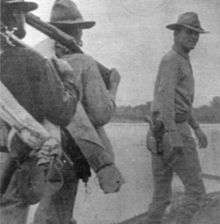 Captain Cornelius C. Smith, a Medal of Honor recipient, with members of the 14th U.S. Cavalry in 1904. Quasi-religious armed groups also fought Americans in assorted provinces. These groups included the pulajanes, so called because of their red garments; the colorum, from a corruption of the Latin in saecula saeculorum part of the Glory Be to the Father prayer; and Dios-Dios, literally "God-God". They were mostly composed of farmers and other poor people, led by messianic leaders such as Dionisio Seguela, a.k.a. Papa Isio ("Isio the Pope"), and subscribed to a blend of Roman Catholic and folk belief. For example, they believed amulets, called agimat or anting-anting, would make them bulletproof. These movements were all dismissed by the American government as bandits, fanatics or cattle rustlers.[1] The last of these groups were defeated or had surrendered by 1913.[1] Moro RebellionMain article: Moro Rebellion
The American government had a peace treaty with the Sultanate of Sulu at the outbreak of the war with Aguinaldo that was supposed to prevent war in Moro territory. However, after the resistance in the north was crippled, the United States began to colonize Moro land, which provoked the Moro Rebellion. Beginning with the Taraca, which occurred on April 4, 1904, American forces battled Datu Ampuanagus, who surrendered after losing 200 members of his people.[1][98] Numerous battles would occur after that up until the end of the conflict on June 15, 1913. During the conflict, the battles of Bud Dajo and Bud Bagsak were among the most notable since casualties included women and children.[2] Political atmosphereAmerican oppositionSome Americans, notably William Jennings Bryan, Mark Twain, Andrew Carnegie, Ernest Crosby, and other members of the American Anti-Imperialist League, strongly objected to the annexation of the Philippines. Anti-imperialist movements claimed that the United States had become a colonial power, by replacing Spain as the colonial power in the Philippines. Other anti-imperialists opposed annexation on racist grounds. Among these was Senator Benjamin Tillman of South Carolina, who feared that annexation of the Philippines would lead to an influx of non-white immigrants into the United States. As news of atrocities committed in subduing the Philippines arrived in the United States, support for the war flagged. Mark Twain famously opposed the war by using his influence in the press. He said the war betrayed the ideals of American democracy by not allowing the Filipino people to choose their own destiny. "There is the case of the Philippines. I have tried hard, and yet I cannot for the life of me comprehend how we got into that mess. Perhaps we could not have avoided it—perhaps it was inevitable that we should come to be fighting the natives of those islands—but I cannot understand it, and have never been able to get at the bottom of the origin of our antagonism to the natives. I thought we should act as their protector—not try to get them under our heel. We were to relieve them from Spanish tyranny to enable them to set up a government of their own, and we were to stand by and see that it got a fair trial. It was not to be a government according to our ideas, but a government that represented the feeling of the majority of the Filipinos, a government according to Filipino ideas. That would have been a worthy mission for the United States. But now—why, we have got into a mess, a quagmire from which each fresh step renders the difficulty of extrication immensely greater. I'm sure I wish I could see what we were getting out of it, and all it means to us as a nation."[99] In a diary passage removed by Twain's first biographical editor Thomas Bigelow Paine, Twain refers to American troops as "our uniformed assassins" and describes their killing of "six hundred helpless and weaponless savages" in the Philippines as "a long and happy picnic with nothing to do but sit in comfort and fire the Golden Rule into those people down there and imagine letters to write home to the admiring families, and pile glory upon glory."[100] Filipino collaborationSome of Aguinaldo's associates supported America, even before hostilities began. Pedro Paterno, Aguinaldo's prime minister and the author of the 1897 armistice treaty with Spain, advocated the incorporation of the Philippines into the United States in 1898. Other associates sympathetic to the U.S. were Trinidad Pardo de Tavera and Benito Legarda, prominent members of Congress; Gregorio Araneta, Aguinaldo's Secretary of Justice; and Felipe Buencamino, Aguinaldo's Secretary of Foreign Affairs. Buencamino is recorded to have said in 1902: "I am an American and all the money in the Philippines, the air, the light, and the sun I consider American." Many such people subsequently held posts in the colonial government.[1] U.S. Army Captain Matthew Arlington Batson formed the Macabebe Scouts[101] as a native guerrilla force to fight the insurgency. Casualties Dead American soldiers inside the coffins during the Philippine–American War. 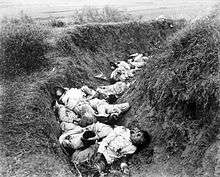 Filipino casualties on the first day of Philippine–American War. The total number of Filipino who died remains a matter of debate. In 1908 Manuel Arellano Remondo, in General Geography of the Philippine Islands, wrote: "The population decreased due to the wars, in the five-year period from 1895 to 1900, since, at the start of the first insurrection, the population was estimated at 9,000,000, and at present (1908), the inhabitants of the Archipelago do not exceed 8,000,000 in number."[102] However, it is not known where Remondo derived his figure for 1895, the official Spanish population estimate was less than 6 million.[103] John M. Gates estimates that at least 15,000~20,000 Filipino soldiers were killed, with up to an additional 200,000 civilian deaths, mostly from a cholera epidemic.[104] Filipino historian E. San Juan, Jr. argues that 1.4 million Filipinos died during the war and that constitutes an act of genocide on the part of the United States.[105] E. San Juan Jr's source quotes a far lower figure.[103] Most sources cite a figure of 200,000 to 250,000 total Filipino civilians dead with most losses attributable to disease.[106][107][108][109][110][111][112][113] The United States Department of State states that the war "resulted in the death of over 4,200 American and over 20,000 Filipino combatants", and that "as many as 200,000 Filipino civilians died from violence, famine, and disease".[114] AtrocitiesAmerican atrocities Enraged by a guerrilla massacre of U.S. troops on the Island of Samar, General Jacob H. Smith retaliated by carrying out an indiscriminate attack upon its inhabitants.[115] His order "KILL EVERY ONE OVER TEN" became a caption in the New York Journal cartoon on May 5, 1902. The Old Glory draped an American shield on which a vulture replaced the bald eagle. The bottom caption exclaimed, "Criminals Because They Were Born Ten Years Before We Took the Philippines". Published in the New York Journal-American, May 5, 1902. Smith was eventually court-martialed by the American military and forced to retire.[115] 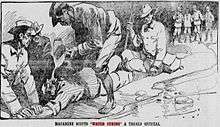 A newspaper depiction from 1902 of water curing by Macabebe Scouts under the United States. American operations into the countryside often included scorched earth campaigns[90] in which entire villages were destroyed; the use of torture including the water cure;[116] and the concentration of civilians into "protected zones".[117] In November 1901, the Manila correspondent of the Philadelphia Ledger wrote: "The present war is no bloodless, opera bouffe engagement; our men have been relentless, have killed to exterminate men, women, children, prisoners and captives, active insurgents and suspected people from lads of ten up, the idea prevailing that the Filipino as such was little better than a dog..."[118] American soldiers' letters and responseThroughout the war American soldiers would write home about the atrocities committed by American forces. In these letters some would criticize General Otis and the U.S. military. When these letters reached anti-imperialist newspaper editors the letters would become national news which would force the War Department to investigate. Two such letters included:
General Otis' investigation of the content of these letters consisted of sending a copy of them to the author’s superior and having him force the author to write a retraction. When a soldier refused to do so, as Private Charles Brenner of the Kansas regiment did, he was court-martialed. In the case of Private Brenner, the charge was "for writing and conniving at the publication of an article which...contains willful falsehoods concerning himself and a false charge against Captain Bishop."[64] Not all such letters that discussed atrocities were intended to criticize General Otis or American actions. Many portrayed U.S. actions as the result of Filipino provocation and thus entirely justified. Concentration campsIn some areas, Filipinos were forced into concentration camps, called reconcentrados, which were surrounded by free-fire zones. These camps were overcrowded which led to disease and death. Between January and April 1902, 8,350 prisoners of approximately 298,000 died. Some camps incurred death rates as high as 20 percent. "One camp was two miles by one mile (3.2 by 1.6 km) in area and 'home' to some 8,000 Filipinos. Men were rounded up for questioning, tortured, and summarily executed."[120] In Batangas Province, where General Franklin Bell was responsible for setting up a concentration camp, a correspondent described the operation as "relentless." General Bell ordered that by December 25, 1901, the entire population of both Batangas Province and Laguna Province had to gather into small areas within the "poblacion" of their respective towns. Barrio families had to bring everything they could carry because anything left behind—including houses, gardens, carts, poultry and animals—was to be burned by the U.S. Army. Anyone found outside the concentration camps was shot. General Bell insisted that he had built these camps to "protect friendly natives from the insurgents, assure them an adequate food supply" while teaching them "proper sanitary standards." The commandant of one of the camps referred to them as the "suburbs of Hell."[120] Filipino atrocitiesU.S. Army General Otis alleged that Filipino insurgents tortured American prisoners in "fiendish fashion". According to Otis, many were buried alive or were placed up to their necks in ant hills. He claimed others had their genitals removed and stuffed into their mouths and were then executed by suffocation or bleeding to death. It was also reported that Spanish priests were horribly mutilated before their congregations, and natives who refused to support Emilio Aguinaldo were slaughtered by the thousands. American newspaper headlines announced the "Murder and Rapine" by the "Fiendish Filipinos."[65] General "Fighting Joe" Wheeler insisted that it was the Filipinos who had mutilated their own dead, murdered women and children, and burned down villages, solely to discredit American soldiers.[65] In January 1899, the New York World published a story about an American soldier, Private William Lapeer, who had allegedly been deliberately infected with leprosy. The veracity of the story, however, has been questioned, and the opinion expressed that the name Lapeer itself is probably a pun.[121] Other events dubbed atrocities included those attributed by the Americans to General Vicente Lukban, allegedly the Filipino commander who masterminded the Balangiga massacre in Samar province, a surprise Filipino attack that killed almost fifty American soldiers. Media reports stated that many of the bodies were mutilated.[122] The attack itself triggered American reprisals in Samar, ordered by General Jacob Hurd Smith, who reportedly ordered his men to kill everyone over ten years old. To his credit, Major Littleton Waller countermanded it to his own men.[123] Smith was court-martialed for this order and found guilty in 1902, which ended his career in the U.S. Army.[124] Waller was acquitted of killing eleven Filipino guides.[125] Sergeant Hallock testified in the Lodge Committee that natives were given the water cure, "... in order to secure information of the murder of Private O'Herne of Company I, who had been not only killed, but roasted and otherwise tortured before death ensued."[126] On the Filipino side, information regarding atrocities comes from the eyewitnesses and the participants themselves. In his History of the Filipino People Teodoro Agoncillo writes that the Filipino troops could match and even exceed American brutality on some prisoners of war. Kicking, slapping, and spitting at faces were common. In some cases, ears and noses were cut off and salt applied to the wounds. In other cases, captives were buried alive. These atrocities occurred regardless of Aguinaldo's orders and circulars concerning the good treatment of prisoners.[127] Worcester recounts two specific Filipino atrocities as follows: "A detachment, marching through Leyte, found an American who had disappeared a short time before crucified, head down. His abdominal wall had been carefully opened so that his intestines might hang down in his face. Another American prisoner, found on the same trip, had been buried in the ground with only his head projecting. His mouth had been propped open with a stick, a trail of sugar laid to it through the forest, and a handful thrown into it. "Millions of ants had done the rest."[128] ConsequencesCultural impactThe influence of the Roman Catholic Church was reduced when the secular United States Government disestablished the Church and purchased and redistributed Church lands, one of the earliest attempts at land reform in the Philippines.[129] The land amounted to 170,917 hectares (422,350 acres), for which the Church asked $12,086,438.11 in March 1903.[130] The purchase was completed on December 22, 1903 at a sale price of $7,239,784.66.[131] The land redistribution program was stipulated in at least three laws: the Philippine Organic Act,[59] the Public Lands Act[132] and the Friar Lands Act.[133][134] Section 10 of the Public Land Act limited purchases to a maximum of 16 hectares for an individual or 1024 hectares for a corporation or like association.[132][135] Land was also offered for lease to landless farmers, at prices ranging from fifty centavos to one peso and fifty centavos per hectare per annum.[132][135] Section 28 of the Public Lands Act stipulated that lease contracts may run for a maximum period of 25 years, renewable for another 25 years.[132][135] U.S. President McKinley, in his instructions to the First Philippine Commission in 1898, ordered the use of the Philippine languages as well as English for instructional purposes, and displace Spanish. The American administrators, used as excuse that finding the local languages to be too numerous and too difficult to learn and to write teaching materials in, ended up with a monolingual system in English, with no attention paid to the other Philippine languages except for the token statement concerning the necessity of using them eventually for the system[136]  Governor General William Howard Taft addressing the audience at the Philippine Assembly in the Manila Grand Opera House, 16 October 1907 In 1901 at least five hundred teachers (365 males and 165 females) arrived from the U.S. aboard the USS Thomas. The name Thomasite was adopted for these teachers, who firmly established education as one of America's major contributions to the Philippines. Among the assignments given were Albay, Catanduanes, Camarines Norte, Camarines Sur, Sorsogon, and Masbate. Twenty-seven of the original Thomasites either died of tropical diseases or were murdered by Filipino rebels during their first 20 months of residence. Despite the hardships, the Thomasites persisted, teaching and building learning institutions that prepared students for their chosen professions or trades. They opened the Philippine Normal School (now Philippine Normal University) and the Philippine School of Arts and Trades (PSAT) in 1901 and reopened the Philippine Nautical School, established in 1839 by the Board of Commerce of Manila under Spain. By the end of 1904, primary courses were mostly taught by Filipinos under American supervision.[137] Philippine independence and sovereignty (1946).jpg) Manuel L. Quezón, the first president of the Commonwealth of the Philippines (from 1935 to 1944) and former revolutionary military commander. On January 20, 1899, President McKinley appointed the First Philippine Commission (the Schurman Commission), a five-person group headed by Dr. Jacob Schurman, president of Cornell University, to investigate conditions in the islands and make recommendations. In the report that they issued to the president the following year, the commissioners acknowledged Filipino aspirations for independence; they declared, however, that the Philippines was not ready for it. Specific recommendations included the establishment of civilian government as rapidly as possible (the American chief executive in the islands at that time was the military governor), including establishment of a bicameral legislature, autonomous governments on the provincial and municipal levels, and a new system of free public elementary schools.[138] The Second Philippine Commission (the Taft Commission), appointed by McKinley on March 16, 1900, and headed by William Howard Taft, was granted legislative as well as limited executive powers. Between September 1900 and August 1902, it issued 499 laws. A judicial system was established, including a Supreme Court, and a legal code was drawn up to replace Spanish ordinances. A civil service was organized. The 1901 municipal code provided for popularly elected presidents, vice presidents, and councilors to serve on municipal boards. The municipal board members were responsible for collecting taxes, maintaining municipal properties, and undertaking necessary construction projects; they also elected provincial governors. In July 1901 the Philippine Constabulary was organized as an archipelago-wide police force to control brigandage and deal with the remnants of the insurgent movement. After military rule was terminated on July 4, 1901, the Philippine Constabulary gradually took over from United States army units the responsibility for suppressing guerrilla and bandit activities.[138] From the very beginning, United States presidents and their representatives in the islands defined their colonial mission as tutelage: preparing the Philippines for eventual independence.[139][140] Except for a small group of "retentionists," the issue was not whether the Philippines would be granted self-rule, but when and under what conditions.[140][141] Thus political development in the islands was rapid and particularly impressive in light of the complete lack of representative institutions under the Spanish. The Philippine Organic Act of July 1902 stipulated that, with the achievement of peace, a legislature would be established composed of a lower house, the Philippine Assembly, which would be popularly elected, and an upper house consisting of the Philippine Commission, which was to be appointed by the president of the United States.[138] The Jones Act, passed by the U.S. Congress in 1916 to serve as the new organic law in the Philippines, promised eventual independence and instituted an elected Philippine senate. The Tydings–McDuffie Act (officially the Philippine Independence Act; Public Law 73-127) approved on March 24, 1934 provided for self-government of the Philippines and for Filipino independence (from the United States) after a period of ten years. World War II intervened, bringing the Japanese occupation between 1941 and 1945. In 1946, the Treaty of Manila (1946) between the governments of the U.S. and the Republic of the Philippines provided for the recognition of the independence of the Republic of the Philippines and the relinquishment of American sovereignty over the Philippine Islands. See also
Notes
References
Further reading
Primary sources
External links
| |||||||||

